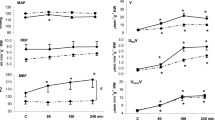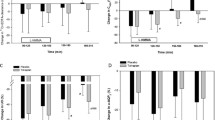Abstract
The pressor, renal and endocrine effect of the physiological precursor of endothelial derived nitric oxide, l-arginine was compared, with a substrate inactive on nitric oxide, hypertonic d-glucose, in hypertensive patients. Ten mild-moderate essential hypertensives were assigned to either l-arginine (n−5) or d-glucose (n−5). Substances were infused over 25 min at equiosmolal rates preceded and followed by saline infusion for 25 min. Blood pressure and heart rate were monitored at 3-min intervals, while hormonal and humoral variables, inulin and paraaminohippurate clearance and electrolyte excretion were measured at the end of each period under conditions of maximal diuresis. l-arginine and d-glucose increased serum osmolality comparably and caused similar haemodilution to that with control saline. During l-arginine infusion, systolic and diastolic blood pressure decreased by 16.6% and 11%, respectively, and recovered in the postinfusion period. Heart rate, plasma renin activity, and plasma noradrenaline did not change significantly. The percent blood pressure decrement induced by l-arginine was significantly greater than that by d-glucose. Glomerular filtration rate was stable and renal plasma flow was increased by both substances. However, natriuresis, kaliuresis and chloruresis were markedly stimulated only by l-arginine, which also promoted the development of systemic acidosis, possibly as a consequence of hydrochloridric acid generated during its metabolism. Circulating insulin, atrial natriuretic peptide, growth hormone and glucagon levels were increased and plasma aldosterone was unchanged during infusion of l-arginine. Insulin was stimulated and the other hormones inhibited during infusion of d-glucose. The greater magnitude and the infusion-related time of the hypotensive action suggests a specific mechanism of action of l-arginine, independent of a changing osmolality. l-arginine-mediated hypotension occurred without evident reflexogenic sympathetic activation and was accompanied by marked natriuresis, kaliuresis and chloruresis without changes in glomerular filtration rate. Both l-arginine and d-glucose increased renal plasma flow comparably.
Similar content being viewed by others
References
Furchgott RF, Zawadzki JV (1980) The obligatory role of endothelial cells in the relaxation of arterial smooth muscle by acetylcholine. Nature 288:373–376
Dinerman JL, Lowenstein CJ, Snyder SH (1993) Molecular mechanisms of nitric oxide regulation. Potential relevance to cardiovascular disease. Circ Res, 73:217–222
Rees DD, Palmer RMJ, Schulz R, Hodson HF, Moncada S (1990) Characterization of three inhibitors of endothelial nitric oxide synthase in-vitro and in-vivo. Br J Pharmacol 101:746–752
Panza J, Casino PR, Badar DM, Quyyumi AA (1993) Effect of increased availability of endothelium-derived nitric oxide precursor on endothelium-dependent vascular relaxation in normal subjects and in patients with essential hypertension Circulation 87:1475–1481
Treasure CB, Manoukian SV, Klein JL, Vita JA, Nabel EG, Renwick GH, Selwyn AP, Alexander RW, Ganz P (1992) Epicardial coronary artery responses to acetylcholine are impaired in hypertensive patients. Circ Res 71: 776–781
Hirschberg RR, Kopple JD (1987) Role of growth hormone in the aminoacid-induced acute rise in renal function in man. Kidney Int 32:382–387
Hirschberg RR, Zipser RD, Slomowitz LA, Kopple JD (1988) Glucagon and prostaglandins are mediators of aminoacid-induced rise in renal hemodynamics. Kidney Int 33:1147–1155
Nakaki T, Hishikawa K, Suzuki H, Saruta T, Kato R (1990) l-Arginine induced hypotension. Lancet 336:696
Creager MA, Gallagher SJ, Girerd XJ, Coleman SM, Dzau VJ, Cooke JP (1992) L-Arginine improves endothelium-dependent vasodilation in hypercholesterolemic humans. J Clin Invest 90:1248–1253
Kanno K, Hirata Y, Emori T, Ohta K, Eguchi S, Imai T, Marumo F (1992) l-Arginine infusion induces hypotension and diuresis/natriuresis with concomitant increased urinary excretion of nitrate/nitrite and cGMP in humans, Clin Exp Physiol Pharmacol, 19:619–625
Badouin SV, Bath P, Martin JF, Du Bois R, Evans TW (1993) l-Arginine infusion has no effect on systemic haemodynamics in normal volunteers, or systemic and pulmonary haemodynamics in patients with elevated pulmonary vascular resistances. Br J Clin Pharmacology 36:45–49
Harima A, Shimizu H, Takagi H (1991) Analgesic effect of l-arginine in patients with persistent pain. Eur J Neuropsycho-pharmacol 1:529–533
Hishikawa K., Nakaki T, Suzuki H, Kato R, Saruta T (1993) Role of l-arginine-nitric oxide pathway in hypertension, J Hypertension, 11:639–645
Seldin DW (1973) Evaluation of clearance methods for localisation of site of action of diuretics. In: Lant AF, Wilson GM (eds) Modern diuretic therapy in the treatment of cardiovascular and renal diseases. Excerpta Medica, Amsterdam, pp 97–110
Malvano R, Zucchelli GC, Rosa U, Salvetti A (1972) Measurement of plasma renin activity by angiotensin I radioimmunoassay (I): an assessment of some methodological aspects. J Nucl Biol Med 16:24–31
Malvano R, Gandolfi C, Giannessi D, Giannotti P, Grosso P (1976) Radioimmunoassay of aldosterone in crude plasma extracts. J Nucl Biol Med, 20:37–44
Clerico A, Del Chicca MG, Giganti M, Zucchelli GG, Piffanelli A (1990) Evaluation and comparison of the analytical performance of two RIA kits for the assay of atrial natriuretic peptide. J Nucl Med All Sci. 34:81–87
Schnurr E, Lahme W, Kupper H (1980) Measurement of renal clearance of inulin and PAH in the steady state without urine collection. Clin Nephrol 13:1045–1051
Battle DC, Hizon M, Cohen E, Gutterman C, Gupta R (1988) The use of the urinary anion gap in the diagnosis of hyperchloremic metabolic acidosis. N Engl J Med 318:594–599
Calver A, Collier J, Vallance P (1991) Dilator effects of arginine in human peripheral vasculature. Clin Sci 81:695–700
Fleckenstein A, Frey M, Zorn J, Fleckenstein-Grun G (1990) Calcium, a neglected key factor in hypertension and arteriosclerosis, In: Laragh JH, Brenner BM (eds) Hypertension: pathophysiology, diagnosis and management. Raven New York, pp 471–519
Mulvihill-Wilson J, Gaffney AF, Pettinger WA, Blomqvist GC, Anderson S, Graham RM (1983) Hemodynamic and neuroendocrine responses to acute and chronic alpha-adrenergic blockade with prazosin and phenoxybenzamine. Circulation 67:383–393
Wolf JP, Nguyen NU, Dumoulin G, Berthelay S (1992) Influence of hypertonic monosaccaride infusions on the release of plasma arginine vasopressin in normal humans Horm Metab Res 24:379–383
Loney LC, Norling LL, Robson AM (1982) The use of arginine hydrochloride infusion to assess urinary acidification. J Pediatri 100:95–98
Cogan MG, Rector FC (1991) Acid-base disorders. In: Brenner BM, Rector FC (eds) The Kidney, 4th edn. Saunders, Philadelphia, pp 18:737–804
Mahnensmith R, Thier S, Cooke R, Broadus A, DeFronzo R: Effect of acute metabolic acidemia on renal electrolyte transport in man. Metabolism (1979) 28: 831–842
Rodriguez-Iturbe Bernardo, Herrera J, Gutkowska J, Parra G, Coello J (1988) Atrial natriuretic factor increases after a protein meal in man. Clin Sci 75:495–498
Pedrinelli R, Panarace G, Spessot M, Taddei S, Favilla S, Graziadei L, Lucarini A, Salvetti A (1989) Low dose atrial natriuretic factor in primary aldosteronism: renal, hemodynamic and vascular effects. Hypertension 14:156–163
Berne C, Fagius J, Niklasson F (1989) Sympathetic response to oral carbohydrate administration. Evidence from microelectrode nerve recordings. J Clin Invest 84:1403–1409
Ferrannini E, Buzzigoli G, Bonadonna R, Giorico MA, Oleggini M, Graziadei L, Pedrinelli R, Brandi L, Bevilacqua S (1987) Insulin resistance in essential hypertension. N Engl J Med 317:350–357
DeFronzo RA, Cooke CR, Andres R, Faloona GR, Davis PJ (1975) The effect of insulin on renal handling of sodium, potassium, calcium and phosphate in man. J Clin Invest 55:845–855
Friedberg CE, Koomans HA, Bijlsma JA, Rabelink TJ, Dorhout Mees EJ (1991) Sodium retention by insulin may depend on decreased plasma potassium. Metabolism 40:201–204
Author information
Authors and Affiliations
Rights and permissions
About this article
Cite this article
Pedrinelli, R., Ebel, M., Catapano, G. et al. Pressor, renal and endocrine effects of l-arginine in essential hypertensives. Eur J Clin Pharmacol 48, 195–201 (1995). https://doi.org/10.1007/BF00198298
Received:
Accepted:
Issue Date:
DOI: https://doi.org/10.1007/BF00198298




